LOS ALAMOS & SANTA FE (Day 3 - part 2)
The museum was separated into distinct sections: history, defense and research. We explored the first two but skipped the last part, which was more hands-on exhibits.

A map of the museum (click for a larger view)
The history section gave detailed information about the Manhattan Project and results of the Trinity test.


A scale model of The Gadget, the prototype for the Fat Man. All the wires lead to detonators that set off the implosion.

A lot of information and photos!

Lieutenant General Leslie Groves and J. Robert Oppenheimer

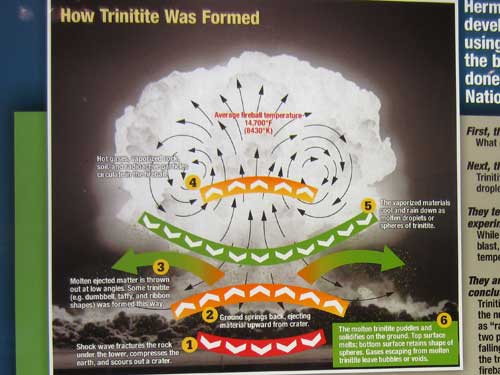
After an explosion of such great force, the desert sand (largely made of silica) melted and became a mildly radioactive light green glass...

... which was named trinitite.

Checking the radioactivity of a piece of tinitite at the Trinity Site in 1945. Not all the material was equally radioactive; it depended on where in the nuclear explosion it was formed. Even seventy years after the test, however, residual radiation at the site is about ten times higher than normal background radiation in the area.

This was a great interactive display where you would 'walk' around the old buildings of Los Alamos.

I'm just trotting along.
The defense section explained about nuclear weapons, plutonium, underground testing, super computers and other explosives.
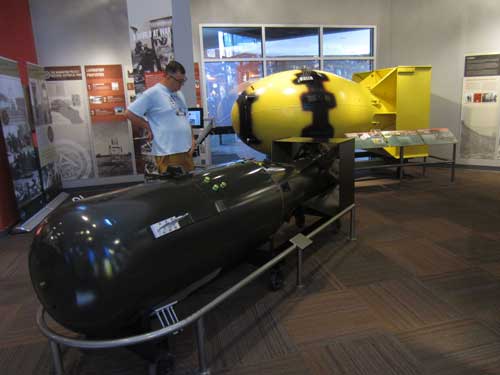
In the foreground is a replica of Little Boy, the first atomic bomb ever to be used in warfare.
- The bomb weighed 9,700 pounds and was 10 feet long.
-It had a blast yield of 15,000 tons of TNT
- It was made using uranium-235
- It was dropped on the city of Hiroshima by the Boeing B-29 "Enola Gay"
All three bombs... Little Boy (uranium gun), Thin Man (plutonium gun) and Fat Man (plutonium implosion)... were named by Robert Serber (1909 - 1997) who worked on the projects. He chose them based on their shapes but also after current entertainment at the time... "The Thin Man" was a detective novel written in 1934 by Dashiell Hammett, and The Fat Man was a character in the 1941 film "The Maltese Falcon." Little Boy was only named in contrast to Thin Man.
Thin Man was a gun-type bomb using plutonium-239 but its design was aborted after many failed attempts (it had aerodynamic instabilities, failed to release immediately, and the spontaneous fission rate of the plutonium was too high for this type of design). It was replaced by Little Boy.
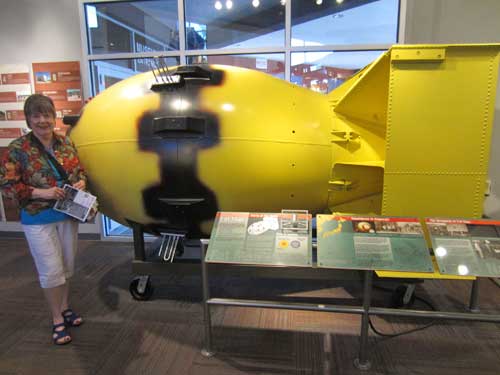
Joanne gives us a sense of scale next to this exact replica of Fat Man, the bomb that was dropped on Nagasaki.
- The bomb weighed 10,800 pounds and produced an explosion equivalent to 21,000 tons of TNT.
- It consisted of a core of plutonium-239 surrounded by explosive chemicals.
-The fins at the back provided stability as it fell.
- The bomb was dropped from an altitude of 29,000 feet and exploded 1,650 feet above the ground.
- Nagasaki was actually the secondary target. Kokura was the primary target but bad weather forced a change of plans.

The aluminum outer case for a W80 warhead (left) was designed to be attached to a cruise missile. An air-launched cruise missile (right) can carry a nuclear warhead in its midsection. It can fly above the treetops at 500 miles per hour, making it very difficult to detect by radar.

Uranium is a radioactive element found in natural ores and is common in the earth's crust. It was discovered in 1789 by a German chemist named Martin Klaproth and named after the planet Uranus, which had been discovered eight years earlier. Uranium was apparently formed in supernovas about 6.6 billion years ago. While it is not common in the solar system, its slow radioactive decay provides the main source of heat inside the Earth today, causing convection and continental drift. It is symbolized by the U on the periodic table and has the atomic number of 92 (which refers to its number of protons). Each atomic number identifies a specific element.
Plutonium (named after Pluto) is synthetically produced, having been discovered in 1940 by scientists studying how to split atoms to make atomic bombs. Plutonium is created in a reactor when uranium atoms absorb neutrons. The different number that follow it, such as Pu-239 or Pu-242, indicates which isotope it is (aka the number of neutrons); its atomic number (in this case 94) stays the same for all its isotopes.
Like all radioactive elements, plutonium eventually decays into more stable elements. The rate of decay is measured in half-life, meaning if we bury a pound of it today, after x-number of years there would be half a pound of the plutonium and half a pound of other materials. After another x-number of years, there'd be 1/4 pound left, and so forth.
The different isotopes have different half-lives: Pu-238 is 88 years; Pu-239 is 24,000 years; Pu-240 is 6,560 years; Pu-241is 14.4 years; Pu-242 is 374,000 years; and Pu-244 has a whopping 82 million years. Substances with shorter half-lives decay more quickly so they emit more energetic radioactivity.
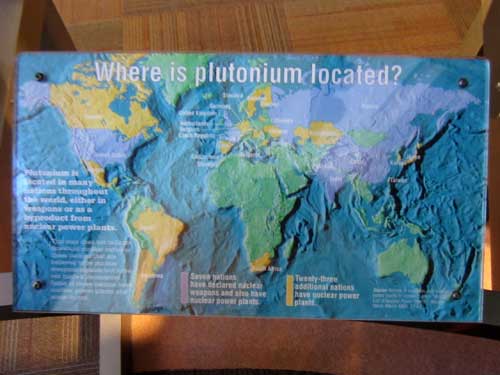
Plutonium is located throughout the world, either in weapons or as a byproduct from nuclear power plants.
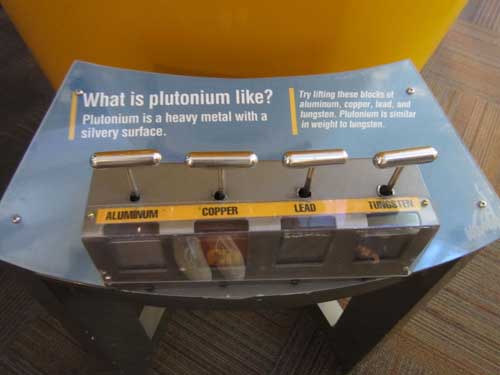
We lifted blocks of aluminum (light), copper (a bit heavier), lead (heavy) and tungsten which is similar in weight to plutonium (quite heavy! Joanne could barely move it!)

During the next 40 years after WWII, the number of nuclear weapons multiplied dramatically as an arms race developed between the USA and the Soviet Union. Each country amassed arsenals containing thousands of nuclear warheads and long-range missiles. In 1991, the two countries agreed to dismantle over 80% of their stockpile and the plutonium cores were put into storage.

Radiation is energy in the form of waves or particles that travels at the speed of light. It actually is a natural part of our world such as visible light, radio waves, x-rays and microwaves. Most radiation is not harmful but some (called ionizing radiation) can carry enough energy to damage living tissue. Think of dangerous medical x-rays or even ultraviolet rays (a less energetic form of radiation) that can burn our skin.

Better safe than sorry. 32 accidents have occurred involving U.S. nuclear weapons, nearly all during the 1950's and 60's. Two caused widespread radioactive contamination.

Plutonium predominantly emits alpha particles, a type of highly ionizing radiation that is easily stopped and has a short range.External exposure to alpha particles isn't much of a health risk. Were it to enter the body through the lungs, however, it could enter the bloodstream, bones and organs, subjecting them to a continual bombardment of radiation and greatly increasing the risk of cancer.

Built in 1951, the Nevada Test Site is located 65 miles northwest of Las Vegas.
Tests were done to gather technical data on nuclear weapons; to study safety, storage and transportation issues; how plutonium's aging affects performance; and to understand the results of the explosions.

In 1963, it was decided that testing was no longer allowed in the atmosphere, outer space or underwater. Hence it went underground.

A Swiss-cheese landscape... 900 tests were conducted at the Nevada Trinity Site. 800 of them were conducted underground at depth from 600 to 2,200 feet in 6 - 12 foot diameter holes. Each hole took 3 to 12 weeks to bore.
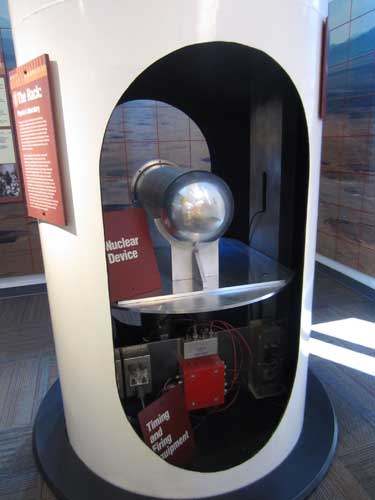
Steel racks were lowered containing both the explosive device and recording instruments. In the millionth of a second before being destroyed, the instruments transmitted their information via fiber-optic cables to detectors located up to 3,500 feet away.

In 1992, all nuclear testing was prohibited.The Dual-Axis Radiographic Hydrodynamic Test (DARHT, pronounced 'dart') became used instead. It provided x-ray images of a detonating nuclear weapon that had been made incapable of producing a nuclear explosion (also called subcritical since no critical mass forms and hence no sustaining nuclear chain reaction occurs).

It has both an inner and outer containment vessel.
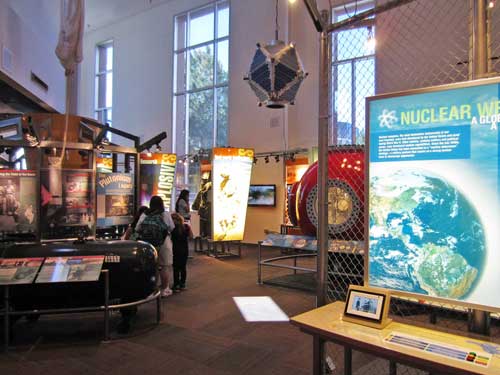
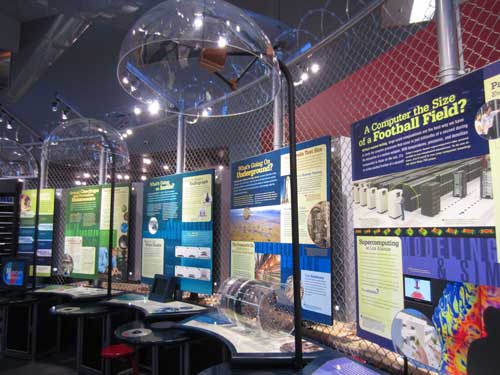
Along with subcritical and laboratory experiments, computer simulations were also used.

The Los Alamos Q machine has more than 4,000 processors and is able to perform 30 trillion operations per second. It covers 22,000 square feet.

The history of super computers started in the early 1960's.
The research section covered such topics as nanotechnology, environmental research, alternative fuels and a tech lab.

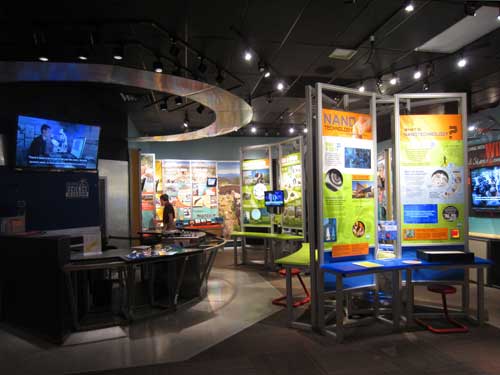
We were headed downtown to park for our next stop when we unexpectedly came across an Model-T car show. The vehicles on display here ranged from 1909 to 1927.


The Tin Lizzies of Albuquerque was founded in 1979 with the mission to encourage the acquisition, preservation, restoration, driving and enjoyment of Model T Fords. (MTFCA = Model T Ford Club of America)




A couple of classics!

I was informed by a guy at the show that it isn't that the cars can't go faster per se, but that their brakes wouldn't be able to stop them if they did! Apparently that was the weak link.

Probably what I enjoy most about these types of cars is how little there is to them... very few gauges, parts where you can see them, everything very mechanical and simple.
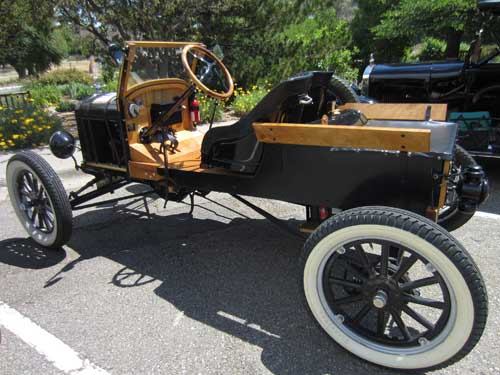

Yup... that's a horn!

A speedometer and odometer in one


Straps to hold down the hood

The dashboard

The thermostat
return • continue

